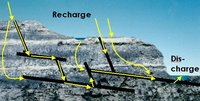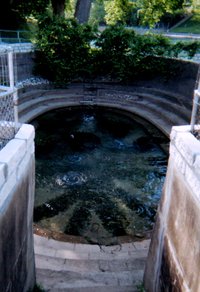Barton Springs
|
|
BartonSprings_MainSpring.jpg
The Barton Springs are four natural springs located on the grounds of Zilker Park in Austin, Texas. The springs are a result of water existing within and flowing through the Edwards Aquifer. The largest spring, Main Barton Spring (also known as "Parthenia" - the mother spring) supplies water to Barton Springs Pool, a popular recreational destination in Austin. The smaller springs are located nearby, some with man-made structures built on top of them to contain and direct their flow. All four springs are the only known home of the Barton Springs Salamander, an endangered species which has received attention from Austin's media and popular culture.
| Contents |
Geology
Barton Springs is the main discharge point for the Barton Springs segment of the Edwards Aquifer of Texas, one of the most famous karst aquifers in the world. Geologically, the aquifer is composed of limestone from the Cretaceous period of geologic history (about 100 million years ago). Fractures, fissures, conduits, and caves have developed in this limestone. Both physical forces (such as faulting) and chemical forces (dissolution of limestone by infiltrating water) have enlarged these void spaces over time. This has resulted in a karst aquifer made up of limestone and large void spaces. Water that enters the aquifer takes up void space wherever it is available.
Originally, all water discharging from Barton Springs originates as rainfall from the atmosphere. Some of this rain falls directly onto the area of land where the aquifer limestone rock is exposed (the recharge zone). Other rainfall lands on area west of the recharge zone and enters into creeks. Eventually, these creeks cross the recharge zone, and some of their water infiltrates into the limestone bedrock.
After water enters the aquifer as recharge, it begins to flow under the force of hydraulic pressure, moving along the gradients created by differences in hydraulic pressure. In the same way water in creeks and rivers flows to the lowest point of elevation, aquifer water tries to flow to the area of lowest hydraulic pressure. This lowest point of hydraulic pressure is Barton Springs.
Main Barton Spring
Main Barton Spring/Parthenia is the most famous, yet possibly least obvious of the four springs. It is located near the diving board in Barton Springs Pool. Since it is completely submerged by the water of the pool, it is not always flowing in a way that is visible at the surface.
On average, the spring discharges about 30,000,000 gallons per day (GPD). The lowest discharge ever recorded was 9,000,000 GPD during the drought of the 1950's, and the highest discharge ever recorded was 85,000,000 GPD during the "Christmas 1991 floods." For comparison, a typical domestic swimming pool holds about 50,000 gallons, and the City of Austin uses about 200,000,000 GPD for its public water supply system.
Other Springs
There are three other springs associated with Barton Springs. They are Eliza, Old Mill, and Upper Barton Spring. They are significantly smaller than Main Barton Spring, with each discharging an average of 3,000,000 gallons per day. Sometimes, they dry up completely.
Eliza Spring, also known as Concession Spring, is located on the northern side of Barton Springs Pool behind the concession stand. During the early 20th century, an amphitheater-style enclosure was built around the spring. While this structure is still present, it is no longer open to the public due to safety concerns, and the fact that Eliza Spring has become a sensitive habitat area for the endangered Barton Springs Salamander.
Old Mill Spring, also known as Sunken Gardens Spring, is located on the southern side of Barton Springs Pool. Like Eliza Spring, it had a man-made structure built around it in the early 20th century, but it now closed to public access due to endangered species habitat issues. Interestingly, scientific analyses show that the water at Old Mill Spring has a slightly different chemistry than that of Main Barton Spring and Eliza Spring, even though it is less than half a mile away from these springs.
Upper Barton Spring is located in the creek bed of Barton Creek, about half a mile upstream of Barton Springs Pool. It frequently goes dry, and can be fully submerged by Barton Creek when it floods. The water at Upper Barton Spring has a significantly different behavior and chemistry than the other three springs.
It should be noted that the entire area around Barton Springs is riddled with faults from the Balcones Fault Zone. There may be other, smaller springs in the area. For example, about one mile upstream of Upper Barton Spring, there is an intermittent spring which fills a popular natural swimming hole.
External links
- Real-time Barton Springs data from USGS (http://waterdata.usgs.gov/tx/nwis/uv?dd_cd=01&dd_cd=15&dd_cd=16&format=gif&period=31&site_no=08155500)
- Save Our Springs Alliance - http://www.sosalliance.org/
- Barton Springs/Edwards Aquifer Conservation District - http://www.bseacd.org/
- http://www.edwardsaquifer.net/barton.html


